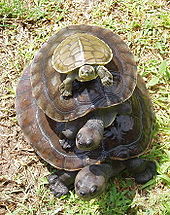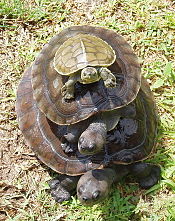Northern river terrapin
| Northern river terrapin | |
|---|---|

| |
| Scientific classification | |
| Domain: | Eukaryota |
| Kingdom: | Animalia |
| Phylum: | Chordata |
| Class: | Reptilia |
| Order: | Testudines |
| Suborder: | Cryptodira |
| Superfamily: | Testudinoidea |
| Family: | Geoemydidae |
| Genus: | Batagur |
| Species: | B. baska
|
| Binomial name | |
| Batagur baska | |
| Synonyms[3] | |
|
click to expand
| |
The northern river terrapin (Batagur baska) is a species of riverine turtle native to Southeast Asia. It is classified Critically Endangered by the IUCN and considered extinct in much of its former range.
Description

The northern river terrapin is one of Asia's largest freshwater and brackwater turtles, reaching a carapace length of up to 60 cm and a maximum weight of 18 kg.[4] Its carapace is moderately depressed, with a vertebral keel in juveniles. The plastron is large, strongly angulate laterally in the young, convex in the adult. The head is rather small, with a pointed and upwards-tending snout. The legs have band-like scales.[5]
The upper surface of the carapace and the soft parts are generally olive-brown, while the plastron is yellowish. Head and neck are brown with reddish bases. Males in breeding coloration have a black head and neck with a crimson or orange dorsal surface and red or orange forelegs. The colour of the pupils also changes during this period, to brown in females and yellow-white in males. During the breeding season, the color of the pupils of a female brown whereas the pupils in the males become yellowish-white.[5][6]
Two subspecies are recognized: B. b. baska (Gray, 1831) and B. b. ranongensis (Nutaphand, 1979).
Distribution and habitat
The species is currently found in Bangladesh (in the Sundarbans), Cambodia, India (parts- West Bengal & Odisha), Indonesia and Malaysia. It is regionally extinct in Myanmar, Singapore, Thailand and Vietnam. It is strongly aquatic but uses terrestrial nesting sites, frequenting the tidal areas of estuaries, large rivers, and mangrove forests.[1]
Ecology
The northern river terrapin is omnivorous, taking waterside plants and small animals such as clams.[7] The species prefers freshwater habitats and moves to brackish river mouths or estuaries in the breeding season (December–March), returning after laying their eggs. Individuals have been known to undertake long seasonal migrations of 50 to 60 miles to the sand banks where they were hatched. Females usually lay three clutches of 10-34 eggs each.[7][8]
Conservation
The species is considered Critically Endangered by the IUCN, principally due to exploitation as a food item (including egg harvesting). Previously, immense numbers were shipped into the fish markets of Calcutta from throughout India; among the Bengali Hindus, the river terrapin was considered the most delectable of all turtles.[9] It is still illegally exported from Indonesia and traded in large numbers in China. Loss of nesting beaches and pollution are also impacting the species.[1]
A hatchery and captive breeding project was established in Vawal National Park at Gazipur in Bangladesh and another in Sajnekhali Forest Station in the Sunderban Tiger Reserve in India with support from Turtle Survival Alliance.[9]
See also
References
- ^ a b c "Batagur baska". IUCN Red List of Threatened Species. 2016: e.T2614A97331162. 2016.
{{cite journal}}: Unknown parameter|authors=ignored (help) - ^ Rhodin, Anders G.J.; van Dijk, Peter Paul; Inverson, John B.; Shaffer, H. Bradley; Roger, Bour (2011-12-31). "Turtles of the world, 2011 update: Annotated checklist of taxonomy, synonymy, distribution and conservation status" (PDF). Chelonian Research Monographs. 5. Archived (PDF) from the original on 2012-01-31.
- ^ Fritz Uwe; Peter Havaš (2007). "Checklist of Chelonians of the World" (PDF). Vertebrate Zoology. 57 (2): 212–213. Archived (PDF) from the original on 2011-05-01. Retrieved 29 May 2012.
- ^ "Northern River Terrapin (Batagur baska)". Turtle Survival Alliance (TSA).
- ^ a b Boulenger, George Albert (1890). The fauna of British India, including Ceylon and Burma: reptilia and Batrachia. Taylor & Francis.
- ^ "An endangered terrapin". The New Indian Express.
- ^ a b "Batagur baska field guide". Asian Turtle Network.
- ^ "Batagur baska". ARKive. Archived from the original on 2015-09-05. Retrieved 2015-09-04.
- ^ a b http://www.iucn-tftsg.org/wp-content/uploads/file/Accounts/crm_5_037_baska_v1_2009.pdf
Further reading
- Das, Indraneil (1989). "Batagur baska in Orissya". Hamadryad: The Journal of the Madras Crocodile Bank Trust. 14 (1): 2–3.
- Gray, J.E. (1857). "Notice of some Indian tortoises (including the description of a new species presented to the British Museum by Professor Oldham)". Annals and Magazine of Natural History. 19 (2): 342–344.


